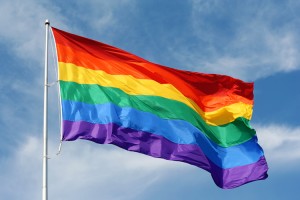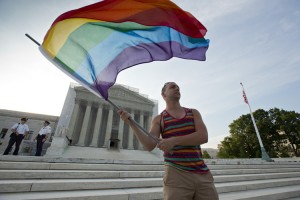40 Years Under the Rainbow
June 26, 2018
Forty years ago this month, in June 1978, members of the Gay Community Center in San Francisco wanted a flag to fly above the California city’s Gay Freedom Day Parade (now a celebration simply called “Pride”). A group of local artists then created the rainbow flag, which would become the international symbol for lesbian, gay, bisexual, and transgender (LGBT) rights. Transgender individuals are those whose identity or self-expression does not match the gender assigned to them at birth. June is LGBT Pride Month in the United States, and cities across the nation host concerts, festivals, colorful parades, parties, and other events that honor the identity, contributions, and historical impact of LGBT people. June is also the month in 2015 when the Supreme Court of the United States ruled that states could not ban same-sex marriage.

The rainbow flag was created for San Francisco’s Gay Freedom Day Parade 40 years ago in June 1978. Credit: © Natasha Kramskaya, Shutterstock
Before 1978, there was no official symbol for LGBT rights. Community organizers in San Francisco wanted something new, something bright and colorful that symbolized diversity, hope, and inclusion. LGBT artist and activist Gilbert Baker—remembered as the “gay Betsy Ross”—is credited with the idea and design for the rainbow flag. Baker worked with seamster James McNamara, tie-dye artist Lynn Segerblom, and a host of other artists and volunteers to create two massive 30 feet-by-60 feet (9 meters-by-18 meters) flags that flew above San Francisco’s United Nations Plaza during the June 1978 Gay Freedom Day Parade. One rainbow flag was much like the version of today. The other version included the star-spangled blue field found on the U.S. flag. The original rainbow flag had eight colored stripes. The six stripes on today’s rainbow flag are (from top to bottom) red, orange, yellow, green, blue, and violet—just as a natural rainbow’s color spectrum appears in the sky. Variations of the flag are used to suit certain causes, cities, or countries.

An activist for lesbian, gay, bisexual, and transgender (LGBT) rights waves a rainbow flag in front of the Supreme Court Building in Washington, D.C. Credit: © AP Photo
LGBT Pride Month developed from LGBT Pride Day, which was celebrated on the last Sunday in June. In June 2000, U.S. President Bill Clinton proclaimed the first Gay and Lesbian Pride Month. George W. Bush skipped the proclamations while he was president, but every year from 2009 through 2016, President Barack Obama officially proclaimed June Lesbian, Gay, Bisexual, and Transgender Pride Month. Donald Trump has issued no such proclamations since becoming president in 2017.


